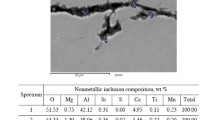Abstract
The main method of eliminating the possibility of having the steel contaminated by nonmetallic inclusions is optimizing the parameters of the ladle treatment on the basis of reliable physicochemical representations of the processes of refining, alloy, and finishing of the steel, the interactions of the metal and slag phases, and other aspects of ladle metallurgy. This article examines the main steps being taken in this direction at the Cherepovets Metallurgical Combine Severstal’ in the production of high-quality automobile sheet 08Yu.
Similar content being viewed by others
References
C. Eijr, O. Grong, and J. Walmasley, “Effect of deoxidation practice on inclusion formation in low alloy structural steels,” in: Proc. VI Int. Conf. Molten Slags, Fluxes, and Salts, Stockholm, Sweden-Helsinki, Finland, June 12-17, 2000, Trita Met., Stockholm (2000), pp. 131–154.
G. A. Filippov, I. G. Rodionova, O. N. Baklanova, et al., “Corrosion resistance of steel pipes,” Tekhnol. Metallov, No. 2, 24–27 (2004).
I. G. Rodionova, O. N. Baklanova, and A. I. Zaitsev, “Role of nonmetallic inclusions in accelerating the local corrosion of oil-and gas-line pipe made of carbon and low-carbon steels,” Metally, No. 5, 3–18 (2004).
E. Kh. Shakhpazov, I. G. Rodionova, O. N. Baklanova, et al., “Improving the corrosion resistance of carbon and low-carbon steels for automobile construction by optimizing the metallurgical technology,” Metallurg, No. 2, 45–48 (2006).
I. G. Rodionov, O. N. Baklanova, and G. A. Filippov, “Role of nonmetallic inclusions in accelerating local corrosion of metal products made of carbon and low-carbon steels,” ibid., No. 4, 48–61 (2005).
Atlas of Slags [Russian translation], Metallurgiya, Moscow (1985).
G. G. Mikhailov, Thermodynamic Principles of Optimization of Deoxidation and the Modification of Nonmetallic Inclusions. Author’s Abstract of Engineering Sciences Doctoral Dissertation, Chelyabinsk (1985).
E. Kh. Shakhpazov, A. I. Zaitsev, A. A. Nemtinov, et al., “Current directions in the growth of ladle metallurgy and the problem of nonmetallic inclusions in steel,” Metally, No. 1, 3–13 (2007).
A. I. Zaitsev, I. G. Rodionova, V. V. Mal’tsev, et al., “Sources of the formation of corrosion-active nonmetallic inclusions (CANI) and ways of ensuring that steels are clean with respect to CANI,” ibid., No. 2, 3–11 (2005).
A. I. Zaitsev, A. D. Litvina, N. P. Lyakishev, and B. M. Mogutnov, Neorganich. Mater., 34, No. 4, 447–451 (1998).
Author information
Authors and Affiliations
Additional information
__________
Translated from Metallurg, No. 8, pp. 58–65, August, 2007.
Rights and permissions
About this article
Cite this article
Zaitsev, A.I., Rodionova, I.G., Karamysheva, N.A. et al. Optimizing the technology for making automobile sheet 08Yu based on the physicochemical principles of ladle metallurgy. Metallurgist 51, 434–445 (2007). https://doi.org/10.1007/s11015-007-0078-1
Issue Date:
DOI: https://doi.org/10.1007/s11015-007-0078-1




